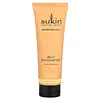What's inside
What's inside
 Key Ingredients
Key Ingredients

 Benefits
Benefits

 Concerns
Concerns

 Ingredients Side-by-side
Ingredients Side-by-side

Oryza Sativa Bran Water
MaskingGlycerin
HumectantOryza Sativa Bran
AbrasiveBambusa Arundinacea Stem Powder
AbrasiveZea Mays Starch
AbsorbentCoco-Glucoside
CleansingXanthan Gum
EmulsifyingJuglans Regia Shell Powder
AbrasivePrunus Amygdalus Dulcis Oil
Skin ConditioningHamamelis Virginiana Flower Water
AstringentVaccinium Myrtillus Fruit/Leaf Extract
AstringentSaccharum Officinarum Extract
MoisturisingCitrus Aurantium Dulcis Fruit Extract
MaskingCitrus Medica Limonum Fruit Extract
Skin ConditioningAcer Saccharum Extract
Skin ConditioningPunica Granatum Fruit Extract
AntioxidantCitrus Grandis Seed Extract
AstringentSilybum Marianum Extract
Skin ConditioningCommiphora Myrrha Oil
MaskingCitrus Grandis Peel Oil
MaskingCitrus Aurantium Bergamia Fruit Oil
MaskingFusanus Spicatus Wood Oil
MaskingVanilla Planifolia Fruit Extract
Skin ConditioningCedrus Atlantica Bark Oil
MaskingAnthemis Nobilis Flower Oil
MaskingCitric Acid
BufferingCocamidopropyl Betaine
CleansingDehydroacetic Acid
PreservativeBenzyl Alcohol
PerfumingOryza Sativa Bran Water, Glycerin, Oryza Sativa Bran, Bambusa Arundinacea Stem Powder, Zea Mays Starch, Coco-Glucoside, Xanthan Gum, Juglans Regia Shell Powder, Prunus Amygdalus Dulcis Oil, Hamamelis Virginiana Flower Water, Vaccinium Myrtillus Fruit/Leaf Extract, Saccharum Officinarum Extract, Citrus Aurantium Dulcis Fruit Extract, Citrus Medica Limonum Fruit Extract, Acer Saccharum Extract, Punica Granatum Fruit Extract, Citrus Grandis Seed Extract, Silybum Marianum Extract, Commiphora Myrrha Oil, Citrus Grandis Peel Oil, Citrus Aurantium Bergamia Fruit Oil, Fusanus Spicatus Wood Oil, Vanilla Planifolia Fruit Extract, Cedrus Atlantica Bark Oil, Anthemis Nobilis Flower Oil, Citric Acid, Cocamidopropyl Betaine, Dehydroacetic Acid, Benzyl Alcohol
Water
Skin ConditioningGlycerin
HumectantPumice
AbrasiveXanthan Gum
EmulsifyingJojoba Esters
EmollientBromelain
Skin ConditioningTerminalia Ferdinandiana Fruit Extract
AntioxidantSqualane
EmollientPassiflora Edulis Seed Powder
AbrasiveCarthamus Tinctorius Extract
EmollientGlucose
HumectantHydroxyethylcellulose
Emulsion StabilisingCitric Acid
BufferingPotassium Sorbate
PreservativeSodium Benzoate
MaskingPhenoxyethanol
PreservativeBenzyl Alcohol
PerfumingParfum
MaskingLimonene
PerfumingWater, Glycerin, Pumice, Xanthan Gum, Jojoba Esters, Bromelain, Terminalia Ferdinandiana Fruit Extract, Squalane, Passiflora Edulis Seed Powder, Carthamus Tinctorius Extract, Glucose, Hydroxyethylcellulose, Citric Acid, Potassium Sorbate, Sodium Benzoate, Phenoxyethanol, Benzyl Alcohol, Parfum, Limonene
Alternatives
Ingredients Explained
These ingredients are found in both products.
Ingredients higher up in an ingredient list are typically present in a larger amount.
Benzyl Alcohol is most commonly used as a preservative. It also has a subtle, sweet smell. Small amounts of Benzyl Alcohol is not irritating and safe to use in skincare products. Most Benzyl Alcohol is derived from fruits such as apricots.
Benzyl Alcohol has both antibacterial and antioxidant properties. These properties help lengthen the shelf life of products. Benzyl Alcohol is a solvent and helps dissolve other ingredients. It can also improve the texture and spreadability.
Alcohol comes in many different forms. Different types of alcohol will have different effects on skin. This ingredient is an astringent alcohol.
Using high concentrations of these alcohols are drying on the skin. They may strip away your skin's natural oils and even damage your skin barrier. Astringent alcohols may also irritate skin.
Other types of astringent alcohols include:
According to the National Rosacea Society based in the US, you should be mindful of products with these alcohols in the top half of ingredients.
Any type of sanitizing product will have high amounts of alcohol to help kill bacteria and viruses.
Learn more about Benzyl AlcoholCitric Acid is an alpha hydroxy acid (AHA) naturally found in citrus fruits like oranges, lemons, and limes.
Like other AHAs, citric acid can exfoliate skin by breaking down the bonds that hold dead skin cells together. This helps reveal smoother and brighter skin underneath.
However, this exfoliating effect only happens at high concentrations (20%) which can be hard to find in cosmetic products.
Due to this, citric acid is usually included in small amounts as a pH adjuster. This helps keep products slightly more acidic and compatible with skin's natural pH.
In skincare formulas, citric acid can:
While it can provide some skin benefits, research shows lactic acid and glycolic acid are generally more effective and less irritating exfoliants.
Most citric acid used in skincare today is made by fermenting sugars (usually from molasses). This synthetic version is identical to the natural citrus form but easier to stabilize and use in formulations.
Read more about some other popular AHA's here:
Learn more about Citric AcidGlycerin is already naturally found in your skin. It helps moisturize and protect your skin.
A study from 2016 found glycerin to be more effective as a humectant than AHAs and hyaluronic acid.
As a humectant, it helps the skin stay hydrated by pulling moisture to your skin. The low molecular weight of glycerin allows it to pull moisture into the deeper layers of your skin.
Hydrated skin improves your skin barrier; Your skin barrier helps protect against irritants and bacteria.
Glycerin has also been found to have antimicrobial and antiviral properties. Due to these properties, glycerin is often used in wound and burn treatments.
In cosmetics, glycerin is usually derived from plants such as soybean or palm. However, it can also be sourced from animals, such as tallow or animal fat.
This ingredient is organic, colorless, odorless, and non-toxic.
Glycerin is the name for this ingredient in American English. British English uses Glycerol/Glycerine.
Learn more about GlycerinXanthan gum is used as a stabilizer and thickener within cosmetic products. It helps give products a sticky, thick feeling - preventing them from being too runny.
On the technical side of things, xanthan gum is a polysaccharide - a combination consisting of multiple sugar molecules bonded together.
Xanthan gum is a pretty common and great ingredient. It is a natural, non-toxic, non-irritating ingredient that is also commonly used in food products.
Learn more about Xanthan Gum